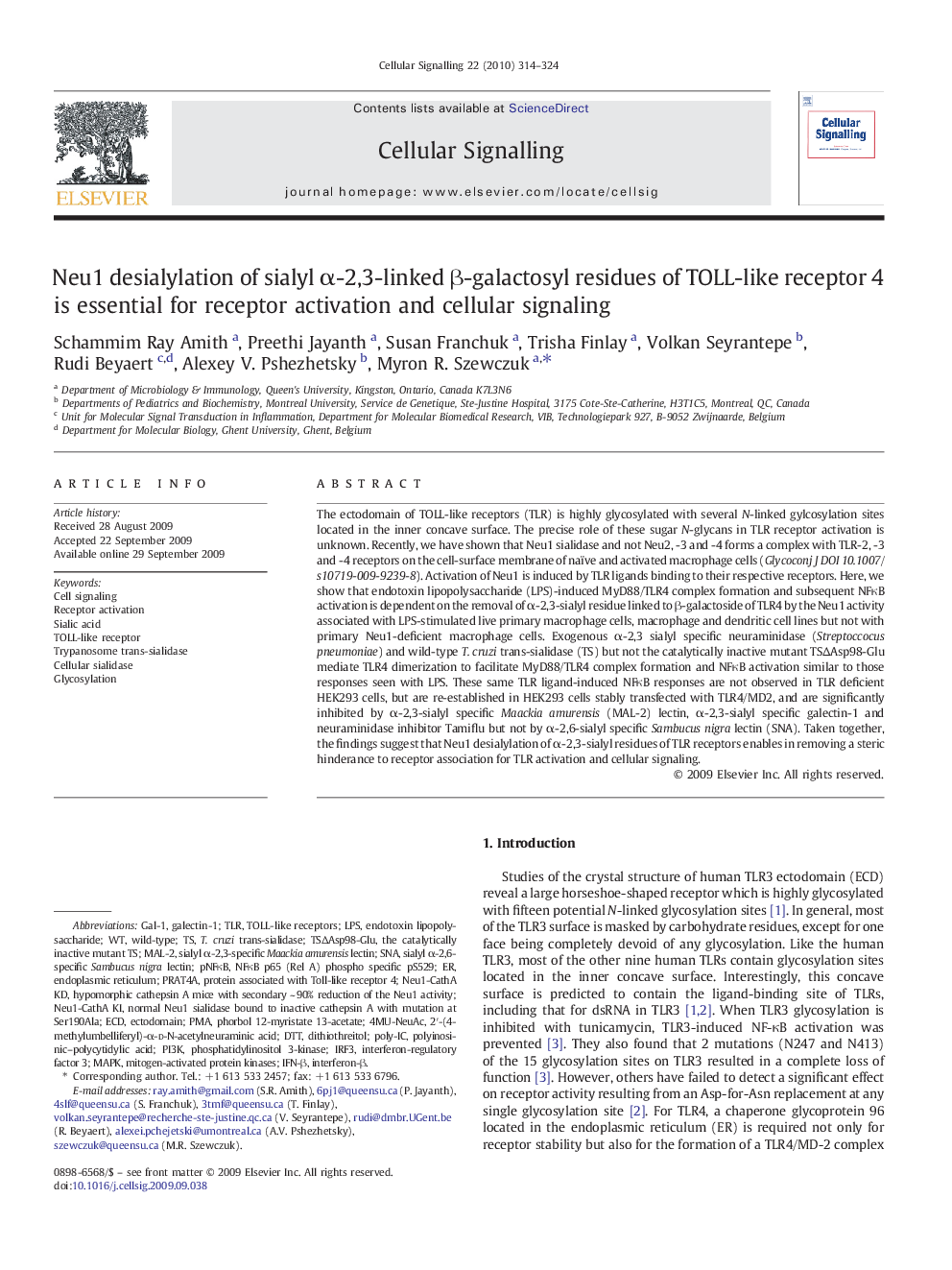| کد مقاله | کد نشریه | سال انتشار | مقاله انگلیسی | نسخه تمام متن |
|---|---|---|---|---|
| 10815850 | 1058506 | 2010 | 11 صفحه PDF | دانلود رایگان |
عنوان انگلیسی مقاله ISI
Neu1 desialylation of sialyl α-2,3-linked β-galactosyl residues of TOLL-like receptor 4 is essential for receptor activation and cellular signaling
دانلود مقاله + سفارش ترجمه
دانلود مقاله ISI انگلیسی
رایگان برای ایرانیان
کلمات کلیدی
TLR2′-(4-Methylumbelliferyl)-α-d-N-acetylneuraminic acidIRF3phorbol 12-myristate 13-acetateSNAPI3KIFN-βECDLPSDTTPMA - LDC هاMAPK - MAPKEctodomain - اکتودومینInterferon-β - اینترفرون-βToll-like receptor - تیالآرdithiothreitol - دیتیوتریتولSialic acid - سیالیک اسیدCell signaling - سیگنالینگ سلولیendoplasmic reticulum - شبکه آندوپلاسمی Phosphatidylinositol 3-kinase - فسفاتیدیلینواستیل 3-کینازReceptor activation - فعال سازی گیرندهwild-type - نوع وحشیPolyinosinic–polycytidylic acid - پلیسی سمی-پلیسییدیدیل اسیدmitogen-activated protein kinases - کیناز پروتئین فعال MitogenGal-1 - گال-1Galectin-1 - گالکتین-1Glycosylation - گلیکوزیله شدنToll-like receptors - گیرنده های پولی مانند
موضوعات مرتبط
علوم زیستی و بیوفناوری
بیوشیمی، ژنتیک و زیست شناسی مولکولی
زیست شیمی
پیش نمایش صفحه اول مقاله

چکیده انگلیسی
The ectodomain of TOLL-like receptors (TLR) is highly glycosylated with several N-linked gylcosylation sites located in the inner concave surface. The precise role of these sugar N-glycans in TLR receptor activation is unknown. Recently, we have shown that Neu1 sialidase and not Neu2, -3 and -4 forms a complex with TLR-2, -3 and -4 receptors on the cell-surface membrane of naïve and activated macrophage cells (Glycoconj J DOI 10.1007/s10719-009-9239-8). Activation of Neu1 is induced by TLR ligands binding to their respective receptors. Here, we show that endotoxin lipopolysaccharide (LPS)-induced MyD88/TLR4 complex formation and subsequent NFκB activation is dependent on the removal of α-2,3-sialyl residue linked to β-galactoside of TLR4 by the Neu1 activity associated with LPS-stimulated live primary macrophage cells, macrophage and dendritic cell lines but not with primary Neu1-deficient macrophage cells. Exogenous α-2,3 sialyl specific neuraminidase (Streptoccocus pneumoniae) and wild-type T. cruzi trans-sialidase (TS) but not the catalytically inactive mutant TSâAsp98-Glu mediate TLR4 dimerization to facilitate MyD88/TLR4 complex formation and NFκB activation similar to those responses seen with LPS. These same TLR ligand-induced NFκB responses are not observed in TLR deficient HEK293 cells, but are re-established in HEK293 cells stably transfected with TLR4/MD2, and are significantly inhibited by α-2,3-sialyl specific Maackia amurensis (MAL-2) lectin, α-2,3-sialyl specific galectin-1 and neuraminidase inhibitor Tamiflu but not by α-2,6-sialyl specific Sambucus nigra lectin (SNA). Taken together, the findings suggest that Neu1 desialylation of α-2,3-sialyl residues of TLR receptors enables in removing a steric hinderance to receptor association for TLR activation and cellular signaling.
ناشر
Database: Elsevier - ScienceDirect (ساینس دایرکت)
Journal: Cellular Signalling - Volume 22, Issue 2, February 2010, Pages 314-324
Journal: Cellular Signalling - Volume 22, Issue 2, February 2010, Pages 314-324
نویسندگان
Schammim Ray Amith, Preethi Jayanth, Susan Franchuk, Trisha Finlay, Volkan Seyrantepe, Rudi Beyaert, Alexey V. Pshezhetsky, Myron R. Szewczuk,